Key takeaways:
- Dialogue must serve a purpose by driving the plot and revealing character traits; intentionality in crafting dialogue is crucial.
- Authentic voices and unique speech patterns bring characters to life, evoking empathy and connection with readers.
- Effective use of subtext, such as pauses, circumlocution, and oppositional lines, enhances emotional depth and relatability in dialogue.
- Editing for naturalness and refining subtext are essential; reading dialogue aloud can help identify areas for improvement.
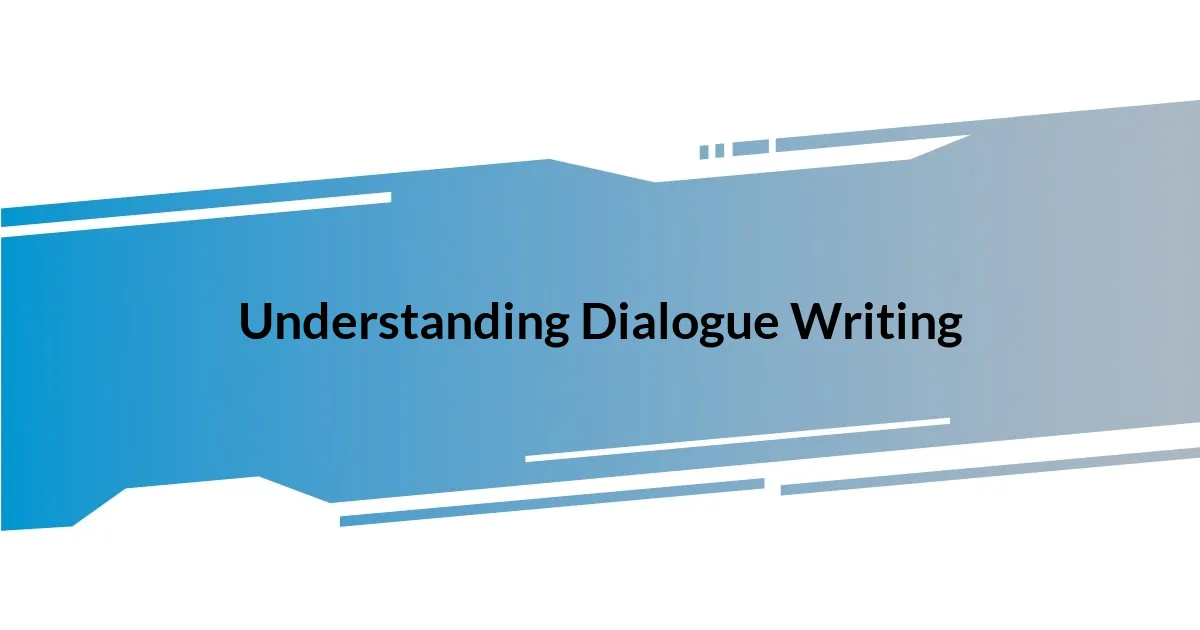
Understanding Dialogue Writing
Understanding dialogue writing is more than just placing words in characters’ mouths; it’s about capturing the essence of their voices and personalities. I remember the first time I wrote a dialogue-heavy scene. I felt a rush of excitement, yet I struggled to ensure each character sounded distinct and authentic. Have you ever found yourself lost in the intricacies of how people communicate?
Dialogue must serve a purpose. It drives the plot, reveals character traits, and often conveys subtext. There have been countless times when I’ve written lines that seemed perfect, only to realize later that they didn’t contribute to the story’s progression or did not reveal anything new about the characters. It’s that “ah-ha” moment that emphasizes the importance of intentionality in crafting dialogue.
When I listen to conversations around me, I often take mental notes. The way people pause, interrupt, or even use body language speaks volumes. One particular coffee shop conversation between two friends stuck with me: the laughter, the teasing, and the comfort in their words painted a vivid picture. How can we strive to replicate such genuine interactions in our writing? Striking that balance between authenticity and storytelling is a challenge, but it’s one worth pursuing.
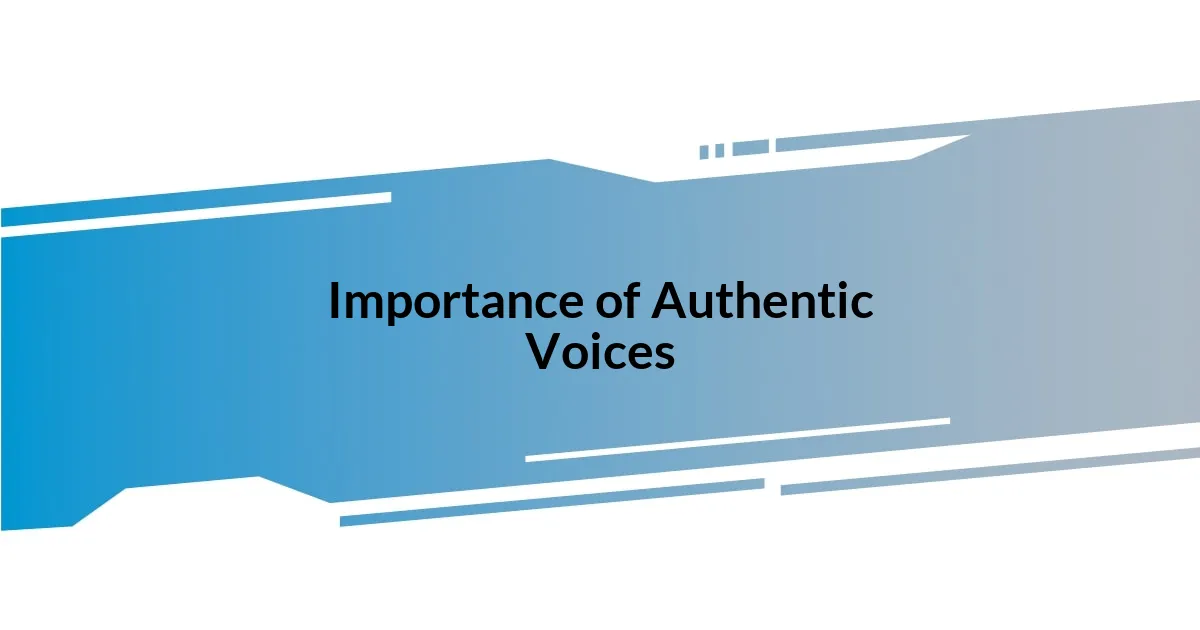
Importance of Authentic Voices
Authentic voices in dialogue bring characters to life. I remember attending a local theater production, where the actors delivered their lines so naturally that I felt like I was eavesdropping on real conversations. That level of authenticity creates an emotional connection with the audience. It’s not just about what characters say; it’s about how they say it.
- Authentic dialogue reflects unique backgrounds and experiences.
- Distinct speech patterns can reveal a character’s personality and motivations.
- Genuine voices evoke empathy, allowing readers to relate to and invest in the characters’ journeys.
When I write dialogue, I often think about how diverse my own circle of friends is. From the quirky friend who uses quirky expressions to the one who speaks in measured, thoughtful phrases, each voice carries its own rhythm and emotion. The richness of these interactions reminds me how crucial it is to let each character have their own authentic voice. Failing to do so can make dialogues sound flat and uninspired. Engaging with real conversations helps me infuse my writing with that same vibrancy.
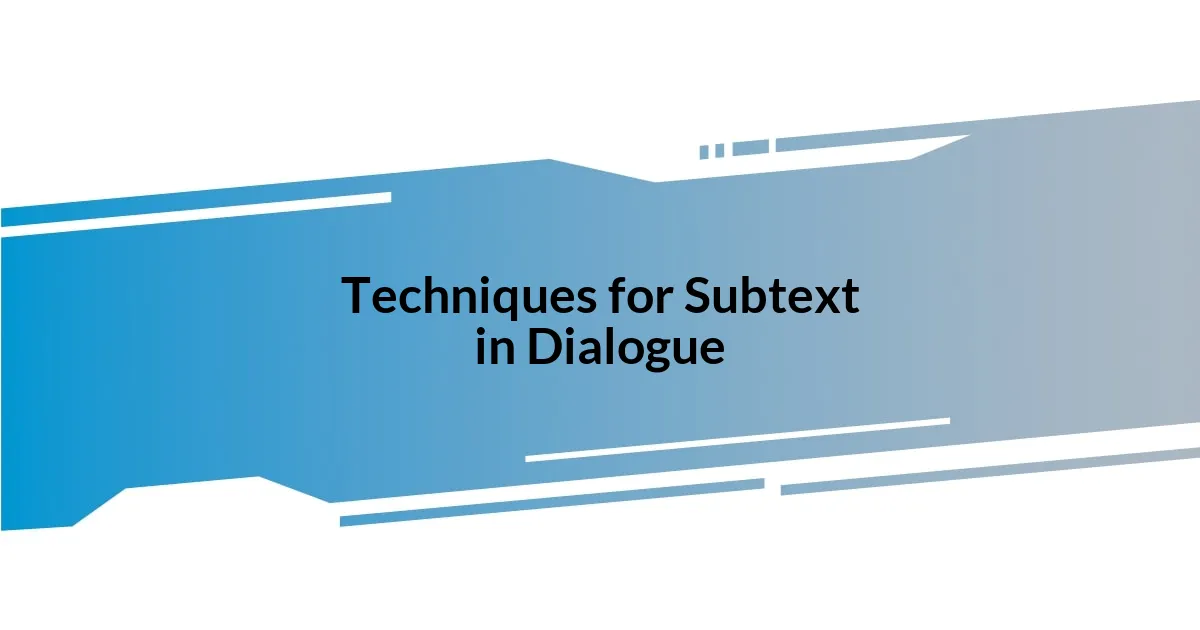
Techniques for Subtext in Dialogue
When crafting subtext in dialogue, I find that one of the most effective techniques is to utilize pauses and silences. These moments can carry so much weight. Imagine two characters discussing a sensitive topic with long pauses between their words. The unsaid becomes as powerful as the spoken, allowing readers to sense tension or unexpressed emotions. I once wrote a scene between a father and daughter where a simple silence spoke volumes. It wasn’t just what they said; it was what they chose not to say that conveyed their unresolved issues.
Another technique I often employ is showing characters speaking in circumlocution instead of directness. This roundabout way of communicating adds layers of meaning. For instance, a character may discuss the weather to avoid addressing a confrontation. I remember writing a conversation between two colleagues where one skirted around mentioning a recent firing while discussing casual topics. The subtext revealed a shared anxiety that was palpable in the air without overt statements. It’s those indirect approaches that make dialogue richer and more relatable.
Coupling oppositional lines can also create compelling subtext. When characters express contrasting views on a single topic, the tension can heighten emotional stakes. I once “listened in” on a very heated discussion among friends about loyalty and betrayal—while one character was passionately defending a friend, another retorted with calculated criticism. I channeled that dynamic into a scene, using contradiction in their dialogue to illustrate the complexity of their relationship. It successfully signified deeper emotional struggles without spelling everything out.
| Technique | Description |
|---|---|
| Pauses and Silences | Utilizing silent moments to signify emotional weight and unexpressed thoughts. |
| Circumlocution | Indirect communication to add layers of meaning and demonstrate avoidance. |
| Oppositional Lines | Contrasting views to heighten emotional stakes and reveal relationship complexities. |
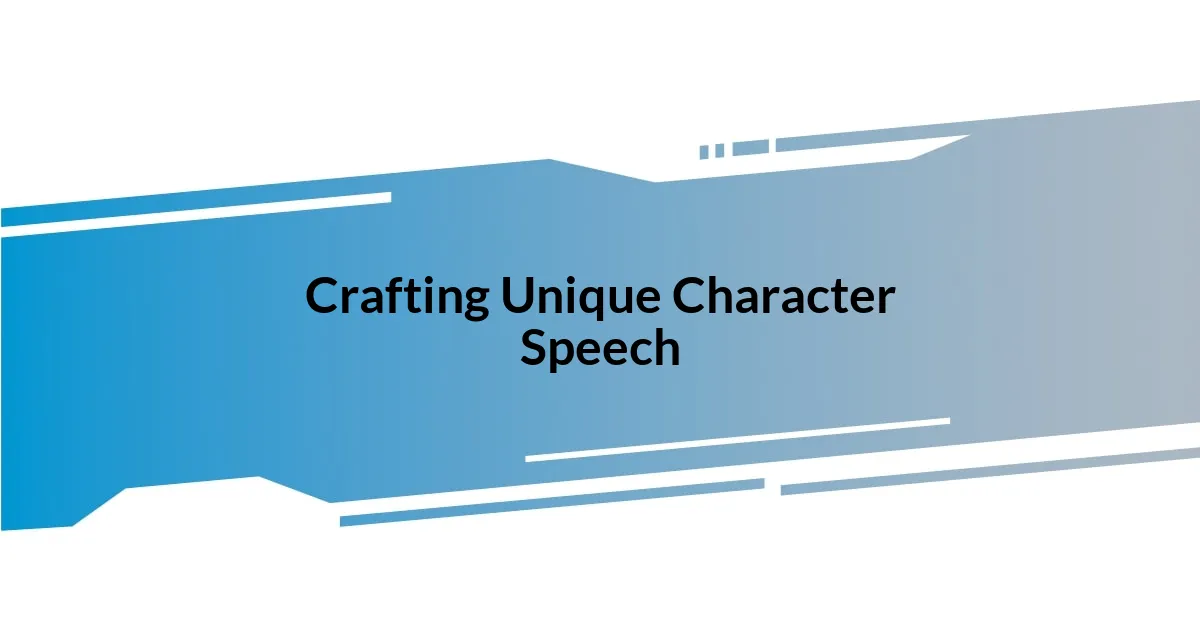
Crafting Unique Character Speech
When I think about crafting unique character speech, I often picture the rhythms of conversation in my own life. For instance, I have a friend who speaks in vivid metaphors, describing a rainy day as “clouds shedding tears.” This distinct language not only reflects her personality but also paints a picture for the listener. I strive to incorporate such identifiers into my characters’ dialogues. It’s fascinating how a simple word choice can convey so much about who they are.
In my writing, I pay close attention to regional influences and cultural backgrounds. Once, I wrote a character from the South who peppered her speech with phrases like “y’all” and “bless your heart.” Every time I read her lines, I could hear the warmth in her voice, which instantly created a connection with readers. It’s a reminder that dialogue isn’t just about accuracy in language; it’s about the emotion and identity that each character carries with them.
One of my favorite exercises is to challenge myself to write a scene where each character has their own speech quirks. I recall a moment when I had two siblings bickering; one was sarcastic while the other was straightforward. This dynamic enriched not only their interactions but also the story itself. So, I ask: what unique elements can you explore in your characters’ speech? Delving into their quirks might reveal insights you didn’t know existed!
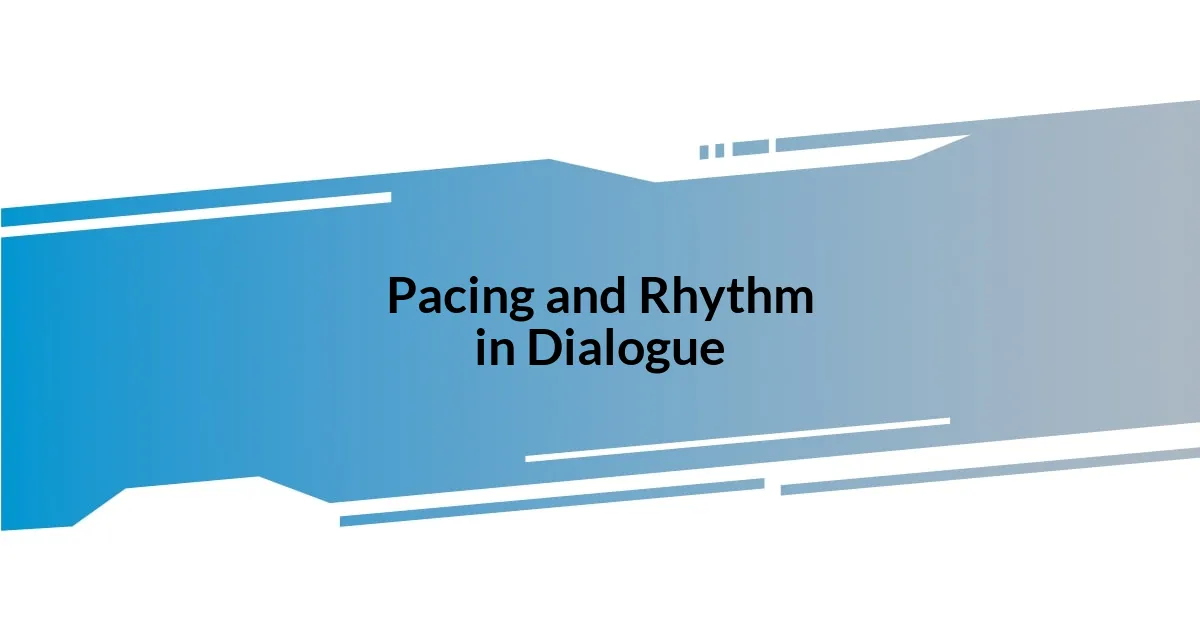
Pacing and Rhythm in Dialogue
Pacing and rhythm in dialogue is something I truly savor. I learned early on that simply speeding up the exchanges can create excitement, while slowing down allows the reader to absorb the characters’ emotions. Once, I wrote a heated exchange between two best friends. The rapid-fire back-and-forth mirrored their palpable frustration, but I strategically added a slower moment where one character hesitated, searching for the right words. It was that pause that brought the tension to a head, reminding me that what isn’t said can be just as gripping as the words chosen.
I often think of rhythm as a musical score. Just as a composer varies tempo to evoke different feelings, I strive to craft dialogue that has its own musicality. In a cozy scene at a coffee shop, I balanced lively banter with softer moments of contemplation. I remember feeling the contrast between the upbeat exchanges filled with laughter and the gentle shifts of life’s deeper reflections. This rhythm not only engaged my readers but also made the characters feel more real and relatable.
At times, I challenge myself to play with pacing through interruptions and overlapping dialogue. It’s fascinating how these techniques can mirror real-life conversations where thoughts often overlap and emotions spill out. I recall a conversation between a couple caught in a misunderstanding—words erupted in a flurry, overlapping like a passionate argument. The rhythm in that scene felt alive and chaotic, which not only captured their emotional state but also made me realize how authentic pacing can elevate a dialogue. Have you ever noticed how real conversations often deviate from the expected flow? Emulating that spontaneity in dialogue adds layers that resonate deeply with readers.
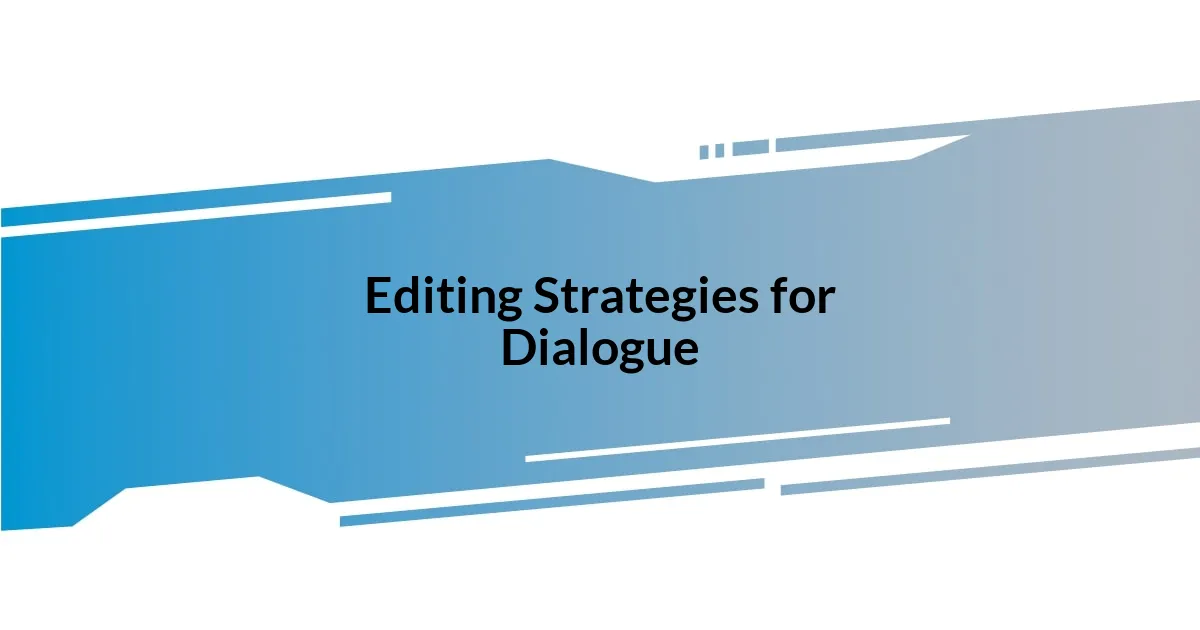
Editing Strategies for Dialogue
Editing dialogue is where the magic often happens, and I love revisiting my own writing with a critical eye. During the editing process, I ask myself: does this dialogue sound natural? Once, I took an early draft of a scene where a character delivered lines that felt overly formal. By swapping some of the stilted words for more casual language, it instantly gave the character a relatable voice. It’s those small tweaks that can transform a conversation into something truly genuine.
As I refine dialogue, I pay close attention to subtext. Characters don’t always say what they truly mean, and that’s a fascinating layer to explore. In one draft, I had a character express frustration overtly, but upon editing, I realized their passive-aggressive comments revealed a deeper emotional struggle. This shift not only made the dialogue more complex but also created a heightened tension in the scene. Have you considered what your characters might be hiding beneath their words?
Moreover, I often read my dialogue out loud, which helps in refining not just the phrasing but also the emotional weight behind each line. During one edit, I performed a scene in front of my mirror—yes, a little quirky, but it works! By vocalizing the lines, I noticed awkward phrases that needed tightening. This sound test highlighted areas where I could enhance authenticity, making characters’ emotions leap off the page. I encourage you to try it; you might be surprised by how much your ears can catch that your eyes might miss!
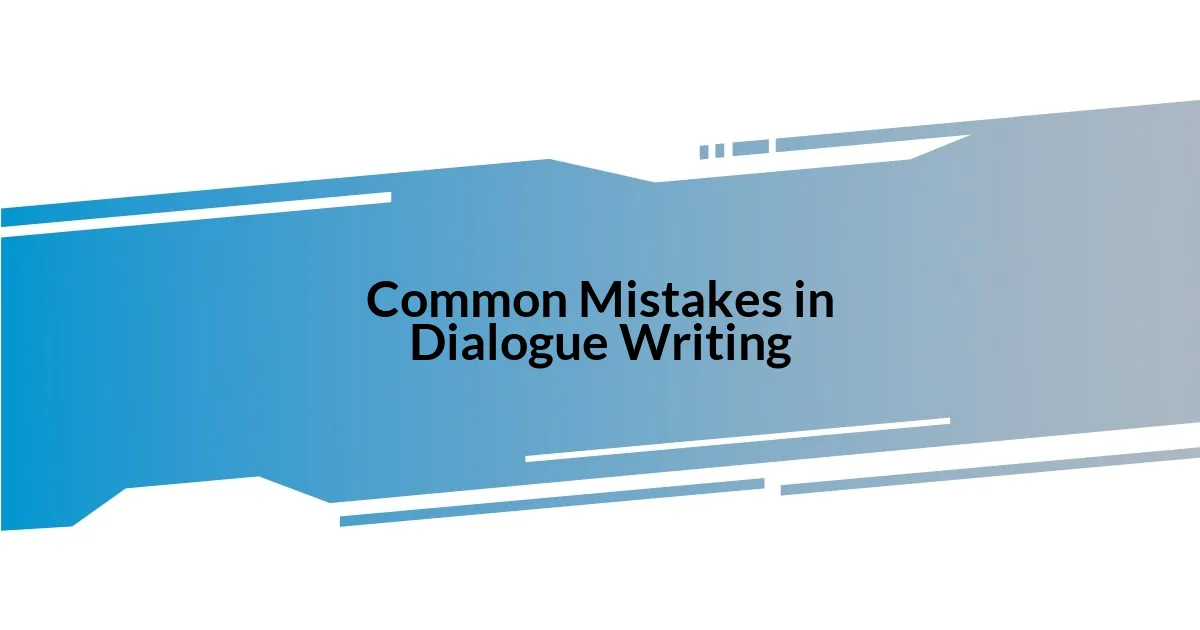
Common Mistakes in Dialogue Writing
In my experience, one of the most common mistakes in dialogue writing is having characters speak in a way that feels forced or unnatural. I remember a time when I crafted a scene where two colleagues were discussing a project, but instead of sounding like real people, their lines felt like a script from a corporate meeting. The moment I reworked those exchanges to include interruptions and casual language, it completely changed the dynamic, making the conversation flow more genuinely. Have you ever noticed how often we gloss over those little nuances that breathe life into dialogue?
Another pitfall is failing to balance dialogue with action or description. I’ve encountered moments in my writing where characters engage in lengthy discussions without any physical grounding. One time, I had a dialogue heavy scene in a park, but readers just couldn’t connect with it because I neglected the atmosphere around them. When I sprinkled in elements like a dog barking in the background or a breeze rustling the leaves, everything clicked into place, giving the words more weight. How do you ensure your dialogue feels anchored in its surroundings?
Lastly, overloading dialogue with exposition can easily bog down the reader. I’ve been guilty of this before, where characters would unload backstories or detailed explanations as if they were reading off a cue card. I remember revising a scene where a character felt compelled to explain their entire history to another. Cutting those lengthy explanations allowed the subtext to shine through, inviting readers to glean the relationship dynamics naturally. Have you considered how much more powerful a well-placed hint can be over an outright declaration?
